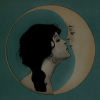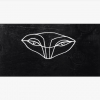[The human form]... is the critical and single locus where a number of sacred forces may converge, and within the overall vodoun quest for unity it is the fulcrum upon which harmony and balance may be finally achieved. The players in this drama are the basic components of man: the "z'etoile", the "gros bon ange", the "ti bon ange", the "n'ame", and the "corps cadavre". The latter is the body itself, the flesh and the blood. The n'ame is the spirit of the flesh that allows each cell of the body to function. It is the residual presence of the n'ame, for example, that gives form to the corpse long after the clinical death of the body. The n'ame is a gift from God, which upon the death of the corps cadavre begins to pass slowly into the organisms of the soil; the gradual decomposition of the corpse is the result of this slow transferral of energy, a process that takes eighteen months to complete. Because of this, no coffin may be disturbed until it has been in the ground for that period of time. The z'etoile is the one spiritual component that resides not in the body but in the sky. It is the individual's star of destiny, and is viewed as a calabash that carries one's hope and all the many ordered events for the next life of the soul, a blueprint that will be a function of the course of the previous lifetime. If the shooting star is bright, so shall be the future of the individual. The two aspects of the vodoun soul, the ti bon ange and the gros bon ange, are best explained by a metaphor commonly used by the Haitians themselves. Sometimes when one stands in the late afternoon light the body casts a double shadow, a dark core and then a lighter penumbra, faint like the halo that sometimes surrounds the full moon. This ephemeral fringe is the ti bon ange - the "little good angel" - while the image at the center is the gros bon ange, the "big good angel". The latter is the life force that all sentient beings share; it enters the individual at conception and functions only to keep the body alive. At clinical death, it returns immediately to God and once again becomes part of the great reservoir of energy that supports all life. But if the gros bon ange is undifferentiated energy, the ti bon ange is that part of the soul directly associated with the individual. As the gros bon ange provides each person with power to act, it is the ti bon ange that molds the individual sentiments within each act. It is one's aura, and the source of all personality, character, and willpower. As the essence of one's individuality, the ti bon ange is the logical target of sorcery, a danger that is compounded by the ease and frequency with which it dissociates from the body. It is the ti bon ange, for example, that travels during sleep to experience dreams. Similarly, the brief sensation of emptiness that immediately follows a sudden scare is due to its temporary flight. And predictably it is the ti bon ange that is displaced during possession when the believer takes on the persona of the loa. At the same time, because it is the ti bon ange that experiences life, it represents a precious accumulation of knowledge that must not be squandered or lost. If and only if it is protected from sorcery and permitted to complete its proper cycle, the ti bon ange may be salvaged upon death of the individual and its legacy preserved. Only in this way may the wisdom of past lives be marshaled to serve the pressing needs of the living. A great deal of ritual effort, therefore, must be expended to secure its safe and effortless metamorphosis. At initiation, for example, the ti bon ange may be extracted from the body and housed in a "canari", a clay jar that is placed in the inner sanctum of the hounfour. In this way the ti bon ange may continue to animate the living while remaining directly within the protective custody of the houngan. Yet even here there are no guarantees. Though it is difficult to kill the one whose ti bon ange has been placed in a canari, if the magic used against the individual is strong enough, the resulting misery may be so great that he will ask the houngan to release the soul that he might end his ordeal. And even if the individual does survive life, he is still at risk in death, for with the demise of the corps cadavre the houngan must break the canari so that the ti bon ange may return to hover about the body for seven days. Then, since the vodounist does not believe in the physical resurrection of the body, the soul must be definitively separated from the flesh, and this takes place during "Dessounin", which is the major death ritual. Throughout this period the ti bon ange is extremely vulnerable, and it is not until it is liberated from the flesh to descend below the dark abysmal waters that it is relatively safe. The ti bon ange remains below in the world of "Les Invisibles" for one day and one year and then, in one of the most important of vodoun ceremonies - the "Wete Mo Nan Dlo" - it is reclaimed by the living and given new form. In place of the body that has decayed, the soul, now regarded as an "esprit", is deposited in another clay jar called a "govi". To the Haitian this reclamation of the dead is not an isolated sentimental act; on the contrary, it is considered as fundamental and inescapable as birth itself. One emerges from the womb an animal, the spiritual birth at initiation makes one human, but it is this final reemergence that marks one's birth as divine essence. The spirits in the govi are fed and clothed and then released to the forest to dwell in trees and grottos, where they wait to be reborn. After the last of sixteen incarnations, the esprit goes to Damballah Wedo, where it becomes undifferentiated as part of the "Djo", the cosmic breath that envelops the universe. The lengthy passage of the ti bon ange corresponds to the metamorphosis of the individual human into pure spiritual energy. Hence, with the successive passing of generations, the individual identified with the esprit in the govi is transformed from the ancestor of a particular lineage in the generalized ancestor of all mankind. Yet even this pure spiritual energy must be made to serve, and for it to function it must become manifest. Thus from the ancestral pool there emerges archetypes, and these are the loa. It is, of course, possession, the return of the spirits to the body of man, that completes the sacred cycle: from man to ancestor, ancestor to cosmic principle, principle to personage, and personage returning to displace the identity of man. Hence, while the vodounist serves his gods, he also gives birth to them, and this is something that is never forgotten; as much as the spirit is the source of the flesh, so the flesh gives rise to the spirit. In place of opposition between the two, there is mutual dependence. Thus the regular arrival of the divine is not considered miraculous, but rather inevitable.
Typed as
Subject to
-
 MOON ~ Corporeality ~ ♓ ~ 100 ~ Q
Formation of the Body, QOPhRA, Pisces
100
MOON ~ Corporeality ~ ♓ ~ 100 ~ Q
Formation of the Body, QOPhRA, Pisces
100


























-
 EMPRESS ~ Illvmination ~ ♀ - 4 - Δ
Fundamental Holiness, DALEThA, Venus
100
EMPRESS ~ Illvmination ~ ♀ - 4 - Δ
Fundamental Holiness, DALEThA, Venus
100


























-
 Snake
Serpent
75
Snake
Serpent
75


























 MOON ~ Corporeality ~ ♓ ~ 100 ~ Q
MOON ~ Corporeality ~ ♓ ~ 100 ~ Q
 EMPRESS ~ Illvmination ~ ♀ - 4 - Δ
EMPRESS ~ Illvmination ~ ♀ - 4 - Δ
 Snake
The Serpent and the Rainbow
Snake
The Serpent and the Rainbow
Wade Davis - The Serpent and the Rainbow

